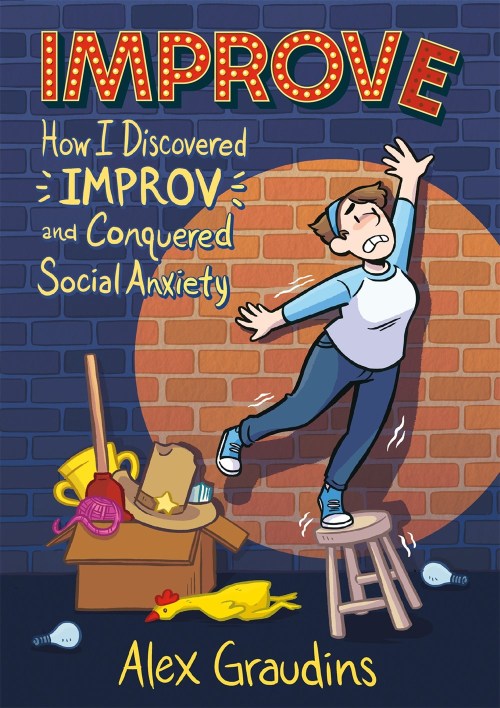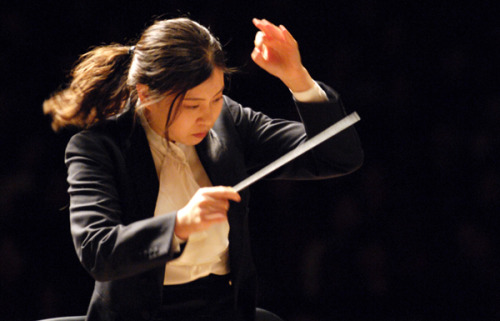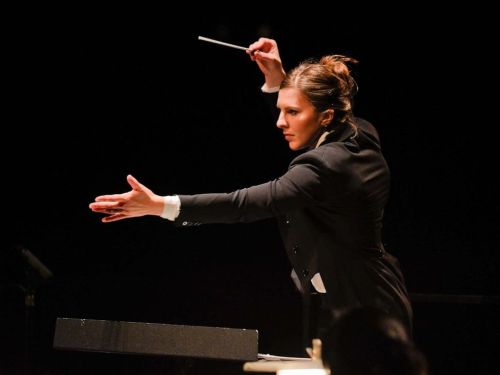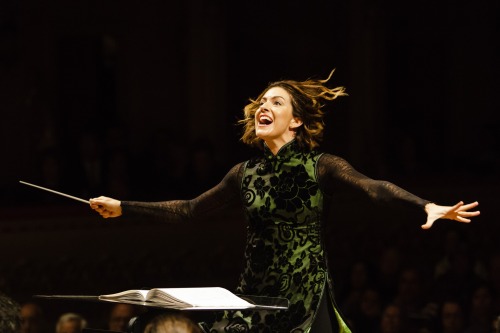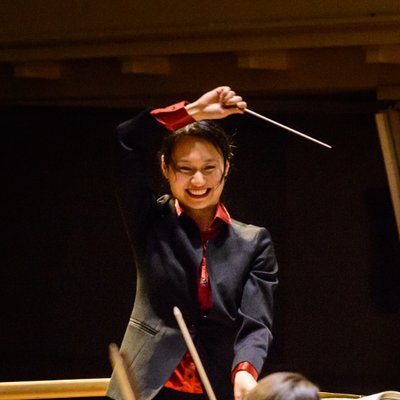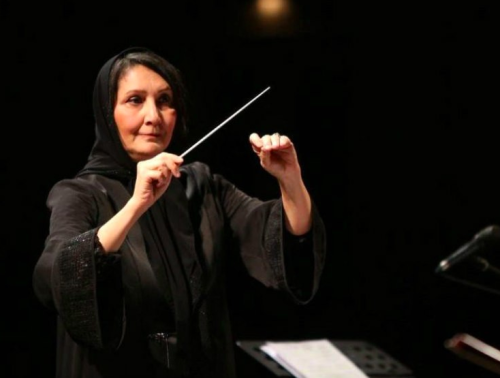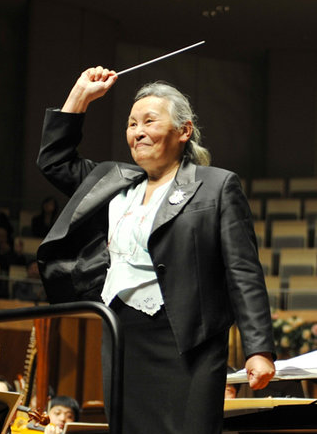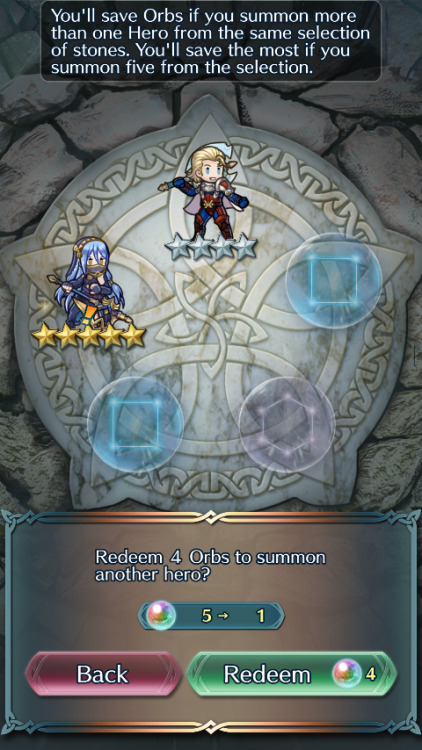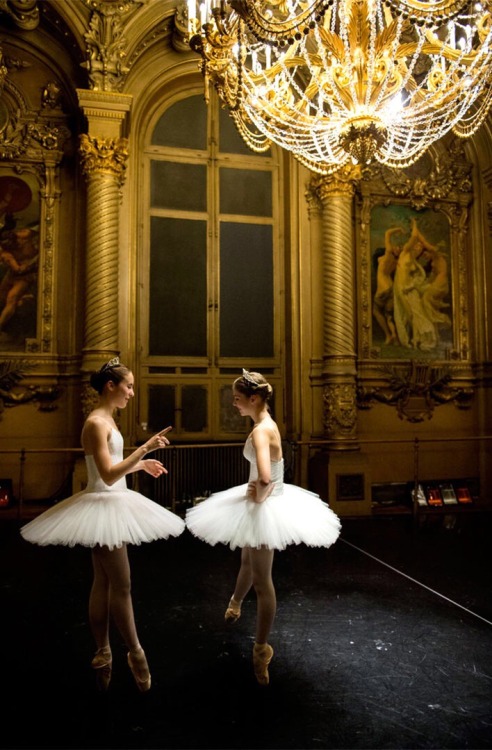#performing arts
IMPROVE
HOW I DISCOVERED IMPROV AND CONQUERED SOCIAL ANXIETY
by Alex Graudins
First Second | Sep 6 | 9781250208231
.
Purchase
Hardcover | Paperback
.
Add to:
A graphic memoir for teens about the author’s efforts to overcome her social anxiety by learning improv comedy.
Alex has crippling social anxiety. All day long, she is trapped in a web of negative thoughts and paralyzing fear. To pull herself free of this endless cycle, Alex does something truly terrifying: she signs up for an improv comedy class. By forcing herself to play silly games and act out ridiculous scenes, Alex confronts the unbearable weight of embarrassment, makes new friends, rediscovers parts of herself that she’d hidden away, and ultimately faces her greatest fear by performing onstage for all to see.
Post link
John Wilkes Booth’s “Richard III”: Staging the Past
What makes this “Richard III” new & unusual?
The Ransom Center’s Cline Curator of Theatre and Performing Arts Eric Colleary and The Hidden Room’s Artistic Director Beth Burns lead a team of award-winning actors, scholars, and designers to resuscitate the ghost of this infamous production based on John Wilkes Booth’s promptbook.
They share how collection materials inspired and informed this forthcoming production as well as respond to your questions.
I like when an article thumbnail features a pic of a woman conductor, as it is the closest I will get to living in a world where newspapers write feel-good human-interest stories about a local witch who is proud to show off her new spell.
Post link










The power this anime holds How this series approaches the issues of masculinity and peer pressure showing Junpei overcoming the fear and breaking the idea of what makes you masculine it’s amazing. I hope everyone can appreciate this.


I forgot how much work it is to clean and paint a stage but it is finally done after 3 hours of prep and 4 hrs of painting! It hasn’t been painted in almost 3 yrs.
Charlotte Landreau, Soloist, Martha Graham Dance Company, 2015. Ken Browar and Deborah Ory. Archival Pigment.
Post link

Sometimes the most complex moves are actually the easiest and most comfortable,when I first saw this move I thought you had to be super flexible to do it and it’s now one of my favourite moves.

Those pointy toes though
The Deluge | Bill Viola | 2002
“iv got music by jmphotography2323”
☛http://bit.ly/1dG7rXS
New Editors’ Choice photo on 500px: Performing Arts
Post link


I’m really passionate about not being homeless and starving.
A week or so back @shomounopostedthis answer to a question about whether Hanyu Yuzuru was gender non-conforming. I thought it was a great question, and also a great answer, one that acknowledges that from a primarily Western point of view, Hanyu, his costumes, his programs and such, would definitely be considered gnc.
And it got me thinking – whatwould the Japanese point of view be? While I’m not a Hanyu fan, and neither am I Japanese (if it matters, I’m Chinese), I live in South Hokkaido, which is 2 hours from Hanyu’s hometown Sendai. Hanyu is an obsession in this area. He is constantly featured on shows, newspapers, and every single competition of his is discussed in detail not only in media but in the workplaces and schools. I may have missed something due to inattention, but I’ve never heard anyone call him too girly. I have heard people accuse him of ‘acting cute’ despite being an adult (a complaint I’ve never heard thrown at models in their 30s who make duck faces and speak in a child-like voice, ahem), but that has more to do with societal expectations of age-appropriateness, not gender. Also, it didn’t strike me that Hanyu himself was motivated by a desire to challenge gender norms in his program choices.
I had an inkling in my mind, but this post ignited enough interest within me to want to read up more and join the discussion when I felt a little more informed. I’d done much research in school regarding gender in Japan, but it was mostly on the representation of women in the media, so I definitely needed to study more before I posted anything. I am still no where near an expert on this subject, but I’d like to present what I’ve learnt within this short week of reading up on the topic of gender norms in Japan. If there is anything that I say that anyone would like to add on to/dispute/etc, please feel free!
So, that being said here’s what I concluded after my readings.
I found that it is not so much that the signifiers of ‘femininity’ (graceful curves, ruffled tops) differ greatly between Japan and say, America, but rather that ‘femininity’ in Japan traditionally has more positive connotations such as courtliness, harmony and culture. I also found that in Japan, ‘femininity’ in the realm of the arts, especially high art – belongs to men. As such, from the perspective of the Japanese, because Hanyu is both an athlete and an artist, his programs will most likely notbe seen as gender non-conforming. In fact by performing femininity, Hanyu as a person will be seen not so much as ‘feminine’ as in more like a woman and/or less like a man, but ‘feminine’ as in a man, but one who is more professional, refined and cultured.
I. Femininity as Japanese Cultural Identity
In this section I will concentrate on Seimei but I think it can also be applied to other recent programs like Notte stellata. As I was scrolling through the ‘yuzuru hanyu’ tumblr tag, I stumbled upon this interview posted by @wherespacepooh, in which Hanyu spoke about his interest in the traditional performance arts and towards wa (peace and harmony). This interview greatly confirmed what I’d been reading with regards to gender norms in Japan – this wa, which is seen as intrinsic to Japanese society and identity, has always been associated with the feminine. And so in pursuing ‘wa programs’, as Hanyu puts it, we should actually expect him to incorporate femininity.
In her book chapter ‘Gender and Japanese Art’ Chino Kaori puts it this way – though “there are many countries and regions in the world that have had a ‘feminine’ identity thrust upon them from the outside…the ‘feminine’ was not forced on (Japan) from without.” From the Heian period, the Japanese chose the ‘feminine’ as the ruling value system within Japan. ‘Femininity’ was associated with courtliness, refinement and elegance – traits of the elite. Most importantly, “‘Femininity’ as a culturally and artistically dominant mode before the Meiji period, does not at all mean ‘female’ but rather the ‘feminine’ embodied by ‘men’”. This ideology thus helped to structure Japanese society and identity.
It is interesting to note that Hanyu’s Seimei is based on a film which itself is based on a historical figure from the Heian period. A period when this conscious adoption of the feminine, defined as gentle and harmonious (wa), became the dominant value system in Japan. A time when the ‘feminine’ traits put men in a position of power.
Chino does acknowledge that during the period of modernisation in the Meiji period onwards, Japan started to consciously portray itself as more ‘masculine’, taking on a more Western view on power and adopting it as their national identity. Still, Kawakatsu Heita, a scholar and the present mayor of the Shizuoka prefecture, suggests that while Japan experienced these changes during the Meiji period and the period following WWII, it never lost its cultural identity – one that is linked tightly to the concept of wa.
Therefore I feel quite strongly that if Hanyu should be praised for breaking any boundaries, I think it should be his fierce desire to bring his Japanese-ness into a Western-dominated field.
@livinginyoureyes also brought up an excellent point in our private conversation, about how the Western media seeing Hanyu as feminine (and negatively so) could be racist in nature. But as I am in no way qualified to talk about that, I’d leave it to her to talk about it if she so wishes.
What I myself can suggest is simply that because the nation and culture in the West is usually associated with the masculine, these Western commentators (and ehm, Leslie Jones?) simply do not know how to read Hanyu’s feminine performances for what they are - A way to express a cultural identity that applies to both men and women.
II. Performance of Femininity as Male Privilege
As shown in the post his costume choices have long gone beyond Western conventions of what is acceptably masculine and into the feminine, even before Hanyu consciously decided to incorporate wa into his programs. And you know, in many ways I don’t think that Japanese will look at something like the Etude costume and be like ‘Uh that’s not feminine’. But rather it’s more a case of, ‘It’s unsurprisingly feminine’.
A lot of it has to do with the dual nature of figure skating. It’s a sport, but it’s also a form of the performing arts. And to the Japanese, femininity in the performing arts, as encapsulated by a male performer, is nothing new. That’s because women were, for a long time, banned from Japanese performing arts. In the past 50 years or so we see actresses return to theatre such as Noh, but by and large males playing female roles in Kabuki, Nihonbuyo and the like, is a tradition that continues to this day.
It’s interesting that even though actresses returned to the Noh stage, even if a female character was played by a female actress, audiences would often first assume that it was simply a very skilled male actor playing the role. Also, in Noh, there is never an attempt to hide an actor’s physiologically features from the audience. A middle-aged actor wearing a female mask for example, could have his jowls showing below the mask, but no one would see this as a problem (see here).
Kabuki theatre is even more fascinating. Take the onnagata, or male actors who played women, for example. Traditionally, they weren’t just supposed to act as women, but live their lives as women to the best of their ability. They were expected to be paradigms of femininity whom biological females were supposed to look up to and learn femininity from. But it is also because of that, that traditional masculinity is never threatened. As scholar Rachel Snyder states, the onnagatas were “participating in hegemonic masculinity in so far as femininity was accepted as a facet of masculinity and masculinity never a facet of femininity.”
Because femininity is an acceptable facet of masculinity, gender performativity (or even embodiment in the onnagatas case) in no way threatens hegemonic masculinity.
If Hanyu displays feminine grace in his programs, then all the more so that as a man he will be seen as a highly-skilled performer. An artist excelling in his craft. In other words, rather than breaking gender conventions, Hanyu as an artist succeeds a long line of male artists from Japanese history to present day who have been praised for their ability to capture, not oppose, feminine grace and elegance. Something that, ironically, a woman will not be praised for as she is not allowed to be a performer in traditional arts.
(On a side note, the most famous example of female performers taking on male roles is undoubtedly the Takarazuka Revue, but to this very day, they have yet to enjoy the elevated status of any of the traditional performing arts. Neither does performance of gender in their case threaten hegemonic masculinity either. Long topic for another day.)
In conclusion, I do think that Hanyu is indeed pushing the boundaries in male figure skating, both technically and artistically, including those of gender norms. But I wouldn’t see him as a champion of such a ‘cause’ as it may be. Rather, I believe it is an unintended consequence, borne of him expressing art and beauty in a way that is influenced (consciously or unconsciously) by his country of origin, and read through Western lenses.
This series has covered dozens of various jobs, but one industry that has not often been featured is performing arts. This month, however, I had the pleasure of interviewing Anu Bhaskararaman, a talented performing artiste and editor in Chennai. Anu has studied and performed in a myriad of dance styles and also uses her Linguistics background in her freelance work as an editor.
You can follow Anu on Instagram (@anubhaskararaman).
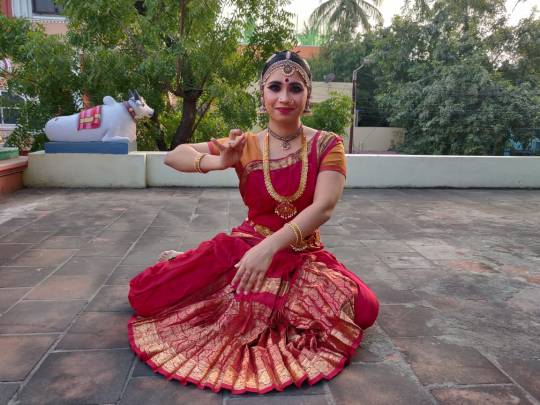
What did you study at university?
I have a BA in English from Stella Maris College, Chennai and an MA in Linguistics from SOAS, University of London. The MA was a general Linguistics Master’s, but a lot of the subjects I chose were in the fields of Documentation and Revitalisation.
What is your job?
I used to work as an editor at a publishing firm in the English Language Department. We worked on textbooks for schools. In India, we have different boards of education and the curriculum for each board is different. We worked on a material for a couple of different boards. After a year of working at the firm, I switched to freelancing as an editor and went full-time into performing arts, focusing on dance. I am a Bharatanatyam dancer and have been training in this form for close to 22 years. I also learnt ballet for two years between 2010 and 2012. In 2018, I went to Attakkalari Centre for Movement Arts, Bangalore, where we trained primarily in Kalaripayattu, Bharatanatyam and Contemporary, and additionally in Chhau, Modern and Ballet.
I have now started classes where I teach Bharatanatyam, and also assist my teacher in her class and perform solo as well with class ensemble. On a daily basis, I teach dance, learn dance and music, have practice sessions at home and my dance class, and also workout. I helped found and edit an online magazine for performing arts in India called Kaleidoculture with a colleague. I also have dance projects that I work on solo as well as with various colleagues, so all of this definitely keeps me busy! Sometimes, there is editing work in addition but the good thing is, since I freelance, I’m able to figure out my schedule. I also end up working from home a lot.
How does your linguistics training help you in your job?
Linguistics does not really come in for me where dance and other performing arts are concerned. However, training in linguistics has been very useful for my editing job. My workplace dealt with textbooks where the focus was on teaching English. For very young grades, being able to understand language acquisition and phonetics to a certain extent, even at a basic level really helped.
I loved studying Linguistics especially because I have loved languages and everything to do about languages since I was very young. From that perspective, I think my degree was useful in helping me understand people and languages around me. I am able to see the many ways in which language affects people and society, so even if it doesn’t directly help in my job right now I would still say that it has been useful.
What was the transition from university to work like for you?
I came back to India after a year in London for my Master’s, but I started looking out for jobs fairly soon. The job hunt was put on the backseat for a bit when performance season came up here. Since I had been away for a year and not had much opportunity to perform, I was looking forward to throwing myself into practice and performance. Once that was done, I got the job at my publishing firm a couple of months later. My workplace was very enthusiastic about the fact that I had studied linguistics and tried to use as much as they possibly could, so the transition was quite easy. It also helped that I had studied and enjoyed studying literature for my undergrad, so it was a nice coming together of sorts of both my degrees.
Do you have any advice you wish someone had given to you about linguistics/careers/university?
I wish someone had told me how useful it would have been to study Linguistics for my BA as well. I loved studying Literature but I also felt like there was a lot I had to catch up on for my Master’s, which only added pressure. I also wish there was more information on pursuing Linguistics in India, especially as a career. It was almost impossible to find a job. I even signed up as a volunteer linguist for a project and did not hear back.
Related interviews:
- Interview with a Freelance Editor, Writer and Trainer
- Interview with a Freelance Translator and Editor
- Interview with an Editor and Copywriter
- Interview with a Dance Instructor and Stay-at-Home Mom
Recent interviews:
- Interview with a Hawaiian and Tahitian language Instructor, Translator & Radio Host
- Interview with a Customer Success Manager
- Interview with an Impact Lead
- Interview with an Online Linguistics Teacher
- Interview with an Academic Linguist
- Interview with a TV Writer
- Interview with a Senior Analyst, Strategic Insights & Analytics
- Interview with a Social Media Lead
Resources:
- The full Linguist Jobs Interview List
- TheLinguist Jobs tag for the most recent interviews
- The Linguistics Jobs slide deck (overview, resources and activities)
The Linguistics Jobs Interview series is edited by Martha Tsutsui Billins. Martha is a linguist whose research focuses on the Ryukyuan language Amami Oshima, specifically honourifics and politeness strategies in the context of language endangerment. Martha runs Field Notes, a podcast about linguistic fieldwork.
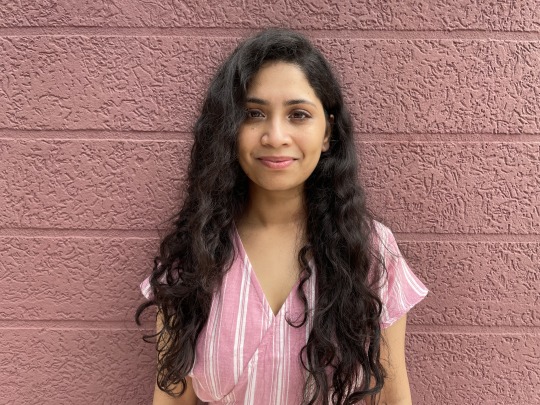
Kaikin theatre play banners with my foxy design are ready. The play starts in the end of August in Kyoto, I wish I was there to see it.
Post link
Managed to get all the dancers I wanted in 200 orbs. Now I wait for blue Azura to come home.
Post link

